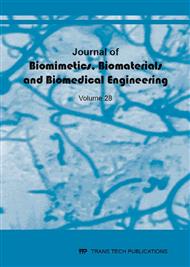[1]
X. Q. Lv, H. L. Wang, D. Z. Jia, M. Zhang, Application of improved boundary distance transform algorithm in virtual endoscopy, J. Computer Simulation 31 (2014) 403-407.
Google Scholar
[2]
J. Xue, H. Y. Su, S. B. Ge, and H. M. Liang, Small intestinal tumors: diagnostic accuracy of enhanced multi-detector CT virtual endoscopy, J. Abdominal Imaging 37 (2012) 465-474.
DOI: 10.1007/s00261-011-9776-z
Google Scholar
[3]
Y. Zhu, H. Y. Su, S. B. Ge, H. M. Liang, Small intestinal tumors: diagnostic accuracy of enhanced multi-detector CT virtual endoscopy, J. Journal of Biomedical Engineering 11 (2013) 80-107.
DOI: 10.1007/s00261-011-9776-z
Google Scholar
[4]
X. Pan, F. Y. Zhou, S. S. Shan et al., Automatic roaming method of virtual endoscope under the minimum rotating frame, J. Journal of computer aided design and graphics 27 (2015) 1548-1554.
Google Scholar
[5]
B. Pradhan, A comparative study on the predictive ability of the decision tree, support vector machine and neuro-fuzzy models in landslide susceptibility and neuro-fuzzy models in landslide susceptibility mapping using, J. Computers & Geosciences 51 (2013).
DOI: 10.1016/j.cageo.2012.08.023
Google Scholar
[6]
O rrù, W. Pettersson-Yeo, A. F. Marquand, et al., Using support vector machine to identify imaging biomarkers of neurological and psychiatric disease: a critical review, J. Neuroscience & Biobehavioral Reviews 36 (2012) 1140-1152.
DOI: 10.1016/j.neubiorev.2012.01.004
Google Scholar
[7]
J. Ji, J. Liu, P. Liang, et al., Learning Effective Connectivity Network Structure from fMRI Data Based on Artificial Immune Algorithm, J. Plos One 11 (2016) 20-82.
DOI: 10.1371/journal.pone.0152600
Google Scholar
[8]
B. Qi, C. Zhao, G. Yin, Feature weighting algorithms for classification of hyperspectral images using a support vector machine, J. Applied Optics 53 (2014) 2839-2846.
DOI: 10.1364/ao.53.002839
Google Scholar
[9]
Y. J. Yang, Research on 3D reconstruction of medical image based on MC algorithm, Hebei University of Technology, Tianjin, (2012).
Google Scholar
[10]
X. Wang, Z. Wang, 3D reconstruction of medical images via nearest neighbor-based Marching Cubes algorithm, J. Computer Engineering & Applications 48 (2012) 154-158.
Google Scholar
[11]
T. Ekeberg, M. Svenda, C. Abergel et al., Three-dimensional reconstruction of the giant mimi virus particle with an x-ray free-electron laser, J. Physical review letters 114 (2015) 98-102.
Google Scholar
[12]
Z. Long, K. Nagamune, A Marching Cubes Algorithm: Application for Three-dimensional Surface Reconstruction Based on Endoscope and Optical Fiber, J. International Information Institute 18 (2015) 14-25.
Google Scholar
[13]
N. Normand, R. Strand, P. Evenou et al., A Streaming Distance Transform Algorithm for Neighborhood-Sequence Distances, J. Image Processing On Line 4 (2014) 196-203.
DOI: 10.5201/ipol.2014.68
Google Scholar
[14]
L. U. Xiao, H. L. Wang, G. Y. Ren, et al., Research on Improving Boundary Distance Transform Algorithm for Virtual Endoscopy, J. Journal of System Simulation 6 (2014) 10-15.
Google Scholar
[15]
D. Abdelaziz, M. Saïd, C. Amine, Automatic Segmentation of the Right Ventricle by Active Shape Model and a Distance Transform, J. Journal of Medical Imaging & Health Informatics 6 (2015) 27-35.
DOI: 10.1166/jmihi.2015.1353
Google Scholar
[16]
M. Sniedovich, Dijkstra's algorithm revisited: the dynamic programming connexion, J. Control & Cybernetics 35 (2006) 599-620.
Google Scholar
[17]
E. Semistad. C. Frank, GPU accelerated segmentation and centerline extraction of tubular structures from medical images, J. International Journal of Computer Assisted Radiology and Surgery 9 (2014) 561-575.
DOI: 10.1007/s11548-013-0956-x
Google Scholar
[18]
L. C. Zhao, J Gao, G. Y. Liu et al., Application of MR virtual endoscopy in children with hydrocephalus, J. Magnetic resonance imaging 33 (2015) 1211-1250.
DOI: 10.1016/j.mri.2015.07.013
Google Scholar
[19]
H. Zeng, G. Ren, Y. Su, Fast automatic roaming algorithm in virtual marine engine room scene, J. Journal of Dalian Maritime University 4 (2012) 0-10.
Google Scholar


